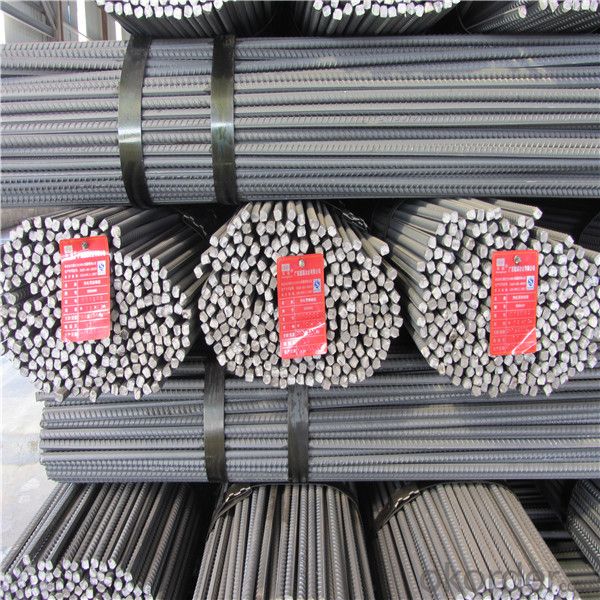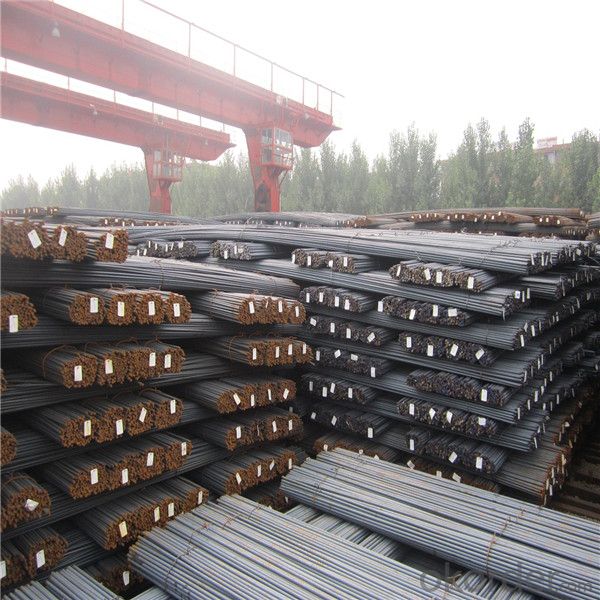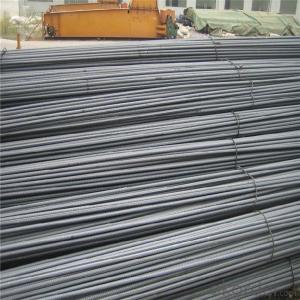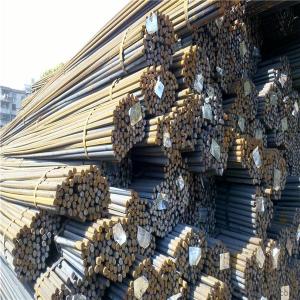Dia 5-50mm Deformed Steel Rebar for construction
- Loading Port:
- Tianjin
- Payment Terms:
- TT OR LC
- Min Order Qty:
- 100 m.t.
- Supply Capability:
- 19000 m.t./month
OKorder Service Pledge
OKorder Financial Service
You Might Also Like
Item specifice
Steel rebar is metal bars often used in construction for pouring concrete or supporting walls and columns. The rebar can
be smooth, though they are frequently manufactured with deformations that create greater texture to which concrete can
adhere, creating a stronger bond that helps prevent cracking of concrete. These deformations do not create weaknesses in
the rebar, and when rebar is measured to determine its diameter, it is typically measured at the narrowest point. Strength
grades indicate the amount of pressure the steel rebar can withstand, and grade and diameter are typically presented in both
imperial and metric units.
Most grades of steel used in rebar cannot accept welding; such as, to adjacent steel plates or as means to bind single
pieces of rebar together. However, special grades of rebar steel and welding rods make welding by expert welders possible.
Features
1、Pure steel quality, stable chemical contents, small tolerance.
2、Constant Quality, good drawing performance.
3、High dimension accuracy degree, accuracy degree of Level C up to 80%, smooth surface, less scale, easy to be pickled.
4、Automatic bundling with 4 lines by Machine in tidy and good looks
5、Big high quality percentage, small coil percentage, and heavy coil weight for Hard Coil.
6、High sorbitizing percentage.
Product Description :
Chemical composition (%): | Steel | C | Si | Mn | P | S | Ceq | ||||
HRB335 |
0.25 |
0.80 |
1.60 |
0.045 |
0.045 | 0.52 | |||||
HRB400 | 0.54 | ||||||||||
HRB500 | 0.55 | ||||||||||
Mechanical properties | Steel | Rel/ MPa | Rm/ MPa | A/ % | Agt/ % | ||||||
≥ | |||||||||||
HRB335 | 335 | 455 | 17 |
7.5 | |||||||
HRB400 | 400 | 540 | 16 | ||||||||
HRB500 | 500 | 630 | 15 | ||||||||
Package: | Standard export packing or as customer's request | ||||||||||
Application: | Construction, building, bridge, road. ect | ||||||||||
Payment terms | 1).100% irrevocable L/C at sight. | ||||||||||
Delivery time | 15-30 days after receipt of L/C or deposit by T/T | ||||||||||


Packing:
In bundles, each bundle weight 3.5 tons. Load by container or by bulk verssel.


Our service
(1) We cooperate with famous factories with advanced equipment and well trained workers.
(2) We can provide factory price with trading company service.
(3) We continuously work on the improvement of our processes, guaranteeing consistently high standards
of quality to keep none compensation.
(4) We guarantee 24 hours response and 48 hours solution providing service.
(5) We accept small order quantity before formal cooperation.
(6) We deliver the agreed quality at the agreed time, reacting to changes in customer wishes in a flexible way.
(7) Due to our volume and selling power, we have excellent freight rates with shipping lines.
(8) We strive to always be fair and honest in our dealings with customers.
(9) We strive to work together with customers to achieve much more than we can achieve alone.
(10) Through our passion and commitment we aim to be a market leader in all our key markets. To maintain
our position as market leader we must continue to add value in all that we do.
FAQ:
1.Q: What's your MOQ(minimum order quantity)?
A: One full container, mixed acceptable .
2. Q: What's your packing methods?
A: Packed in bundle or bulk ..
3. Q: How can I buy CNBM products in my country?
A:Please send us an inquiry or email ,we will reply to you if there is distributor in your country
4. Q: Can we visit your factory?
A: Warmly welcome. Once we have your schedule, we will arrange the professional sales team to follow up your case.
5. Q: How long does it take to get the product if i place an order?
A:With the process of your requirements,we will pack and deliver in 3-7 days. If it is by sea shipment,it will take 15-45 days depending on different locations
- Q:How are steel rebars measured and priced?
- Steel rebars are priced and measured based on their length and weight, with weight typically measured in pounds or kilograms and length in feet or meters. The weight of a rebar is determined by its diameter, commonly gauged in millimeters or inches. To determine the cost of a steel rebar, the weight is multiplied by the cost per unit weight, which may differ depending on factors such as the steel type, market demand, and supplier. This cost is generally quoted in terms of cost per pound or cost per kilogram. Besides weight and length, other factors like steel grade, manufacturing process, and any additional treatments or coatings applied to the rebar can also impact pricing. It is crucial to note that steel rebar prices can vary among suppliers. Thus, it is advisable to obtain multiple quotes and compare them before making a purchasing decision.
- Q:How do steel rebars contribute to the strength of a structure?
- Steel rebars contribute to the strength of a structure by providing reinforcement and enhancing its structural integrity. These high-strength steel bars are embedded within concrete to resist tensile forces that concrete alone cannot withstand. By distributing stress and preventing cracking or failure, rebars help ensure the overall stability and durability of the structure, especially in areas prone to seismic activity or heavy loads.
- Q:How are steel rebars anchored into existing concrete?
- Steel rebars are typically anchored into existing concrete by using different methods such as epoxy adhesive, mechanical anchoring systems, or by simply embedding the rebars into the fresh concrete during construction.
- Q:Can steel rebars be used in railway construction?
- Yes, steel rebars can be used in railway construction. They are commonly used to reinforce concrete structures such as railway track foundations, bridges, and retaining walls. The use of steel rebars provides added strength and durability to withstand the heavy loads and constant vibrations associated with railway operations.
- Q:What are the recommended practices for welding steel rebars?
- To achieve a strong and reliable bond when welding steel rebars, certain recommended practices should be followed. These practices encompass: 1. Cleanliness: Prior to welding, it is crucial to ensure that the surfaces of the rebars are clean and devoid of any contaminants such as dirt, rust, or grease. Wire brushing or sandblasting can be employed to achieve a thorough cleaning. 2. Preheating: Preheating the steel rebars before welding can minimize the risk of cracking and enhance the weld's quality. The preheating temperature should be determined based on the rebar's thickness and the specific welding procedure being used. 3. Welding process: There are various welding processes suitable for steel rebars, with shielded metal arc welding (SMAW) and gas metal arc welding (GMAW) being the most commonly used. The choice of process is influenced by factors like rebar size, project requirements, and local regulations. 4. Electrodes and filler material: It is crucial to select electrodes and filler materials that are suitable for achieving a strong and durable weld. It is recommended to use materials that match the rebar's carbon content and strength. 5. Welding technique: Employing proper welding techniques, such as maintaining a consistent arc length, controlling the travel speed, and ensuring proper joint alignment, is essential for producing high-quality welds. 6. Post-weld treatment: After welding, it is important to allow the welded rebars to cool gradually to prevent thermal stress. Performing post-weld treatments, such as stress relieving, can also help minimize residual stresses and improve the weld's integrity. 7. Inspection and testing: Regular visual inspections and non-destructive testing, such as ultrasonic or magnetic particle testing, should be conducted to ensure the quality and integrity of the welded rebar joints. 8. Compliance with codes and standards: It is vital to always adhere to the relevant welding codes and standards specified by local authorities or project requirements. Compliance ensures that the welding process and quality meet the necessary specifications and safety guidelines. It should be noted that welding steel rebars should only be performed by trained and qualified personnel who possess extensive knowledge of welding techniques and safety practices. By following these recommended practices, the strength, durability, and safety of steel rebar welds can be ensured.
- Q:What is the purpose of using stirrups with steel rebars?
- The purpose of using stirrups with steel rebars is to provide lateral support and prevent the rebars from buckling or sliding when subjected to tensile or compressive forces. Stirrups help enhance the structural integrity and overall strength of reinforced concrete structures, ensuring they can withstand various loads and stresses.
- Q:What is the weight of a standard steel rebar?
- The weight of a standard steel rebar can vary depending on its length and diameter. On average, a 1-meter long steel rebar with a diameter of 12 millimeters weighs around 0.89 kilograms.
- Q:What is the difference between hot-rolled and cold-rolled steel rebars?
- The main difference between hot-rolled and cold-rolled steel rebars lies in the manufacturing process. Hot-rolled steel rebars are formed by heating the steel billet to high temperatures and then passing it through rollers to shape it into the desired rebar size. This process results in a rougher surface and less precise dimensions. On the other hand, cold-rolled steel rebars are manufactured by cooling the steel billet and then passing it through rollers at room temperature. This process produces a smoother surface and more accurate dimensions. Overall, the choice between hot-rolled and cold-rolled steel rebars depends on the specific application and the desired properties of the rebar.
- Q:What is the process of installing steel rebars in slabs and beams?
- To ensure the concrete structure is properly reinforced, there are several steps involved in installing steel rebars in slabs and beams. Firstly, the reinforcement layout is designed by the structural engineer based on the project's specific requirements. Factors such as load-bearing capacity and span length are taken into consideration. Next, the layout is marked on the slab or beam using appropriate methods like chalk lines. This helps guide the installation process and maintain accuracy. Then, the steel rebars, which are delivered in long lengths, need to be cut and bent to the specific dimensions and angles required by the design. Specialized tools such as rebar cutters and benders are used for this process. Once the rebars are cut and bent, they are placed in the marked positions on the slab or beam. Rebar chairs, spacers, or other devices are used to support the rebars and keep them in the correct position during concrete pouring. After the rebars are correctly positioned, they are tied together using wire or other binding material to maintain proper spacing and alignment. An inspection is then carried out to ensure the rebars meet the design specifications and are properly positioned. Compliance with building codes and standards is checked. Once the rebars are inspected and approved, the concrete is poured over the reinforced area. The rebars act as reinforcement, providing added strength and stability to the structure. After the concrete is poured, it needs to cure and harden. During this time, it is important to protect the rebars and concrete from excessive moisture and temperature fluctuations. Finishing processes like leveling, smoothing, and surface treatments can be carried out after curing to achieve the desired appearance and functionality. Overall, the process of installing steel rebars in slabs and beams involves meticulous planning, precise cutting and bending, accurate placement, proper securing, and thorough inspection. This ensures a reinforced structure that meets design requirements and provides long-lasting strength and durability.
- Q:What are the recommended practices for welding steel rebars?
- When it comes to welding steel rebars, there are some recommended practices that ensure a strong and reliable bond. These practices include: 1. Cleanliness: Before welding, it is crucial to ensure that the rebar surfaces are clean and free from any contaminants such as dirt, rust, or grease. A thorough cleaning can be achieved through wire brushing or sandblasting. 2. Preheat: Preheating the steel rebars before welding can help reduce the risk of cracking and improve the quality of the weld. The preheating temperature will depend on the rebar's thickness and the specific welding procedure being used. 3. Welding process: There are various welding processes suitable for steel rebars, with the most commonly used being shielded metal arc welding (SMAW) and gas metal arc welding (GMAW). The choice of process will depend on factors such as the rebar size, project requirements, and local regulations. 4. Electrodes and filler material: Selecting the appropriate electrodes and filler material is crucial for achieving a strong and durable weld. It is recommended to use electrodes and filler materials that match the rebar's carbon content and strength. 5. Welding technique: Employing proper welding techniques, such as maintaining a consistent arc length, controlling the travel speed, and ensuring proper joint alignment, will help produce high-quality welds. 6. Post-weld treatment: After welding, it is essential to allow the welded rebars to cool gradually to avoid thermal stress. It is also recommended to perform post-weld treatments, such as stress relieving, to minimize residual stresses and improve the weld's integrity. 7. Inspection and testing: Conducting regular visual inspections and non-destructive testing, such as ultrasonic or magnetic particle testing, can help ensure the quality and integrity of the welded rebar joints. 8. Compliance with codes and standards: Always adhere to the relevant welding codes and standards specified by local authorities or project requirements. Compliance ensures that the welding process and quality meet the necessary specifications and safety guidelines. It is important to note that welding steel rebars should be performed by trained and qualified personnel who are well-versed in welding techniques and safety practices. Following these recommended practices will help ensure the strength, durability, and safety of steel rebar welds.
1. Manufacturer Overview |
|
|---|---|
| Location | |
| Year Established | |
| Annual Output Value | |
| Main Markets | |
| Company Certifications | |
2. Manufacturer Certificates |
|
|---|---|
| a) Certification Name | |
| Range | |
| Reference | |
| Validity Period | |
3. Manufacturer Capability |
|
|---|---|
| a)Trade Capacity | |
| Nearest Port | |
| Export Percentage | |
| No.of Employees in Trade Department | |
| Language Spoken: | |
| b)Factory Information | |
| Factory Size: | |
| No. of Production Lines | |
| Contract Manufacturing | |
| Product Price Range | |
Send your message to us
Dia 5-50mm Deformed Steel Rebar for construction
- Loading Port:
- Tianjin
- Payment Terms:
- TT OR LC
- Min Order Qty:
- 100 m.t.
- Supply Capability:
- 19000 m.t./month
OKorder Service Pledge
OKorder Financial Service
Similar products
New products
Hot products
Related keywords



























